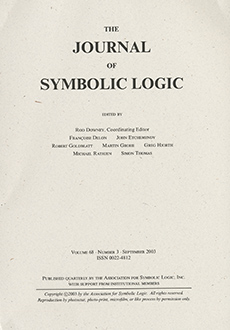Abstract
Khutoretskii's Theorem states that the Rogers semilattice of any family of c.e. sets has either at most one or infinitely many elements. A lemma in the inductive step of the proof shows that no Rogers semilattice can be partitioned into a principal ideal and a principal filter. We show that such a partitioning is possible for some family of d.c.e. sets. In fact, we construct a family of c.e. sets which, when viewed as a family of d.c.e. sets, has (up to equivalence) exactly two computable Friedberg numberings μ and ν, and μ reduces to any computable numbering not equivalent to ν. The question of whether the full statement of Khutoretskii's Theorem fails for families of d.c.e. sets remains open.
Citation
Serikzhan A. Badaev. Steffen Lempp. "A decomposition of the Rogers semilattice of a family of d.c.e. sets." J. Symbolic Logic 74 (2) 618 - 640, June 2009. https://doi.org/10.2178/jsl/1243948330
Information





